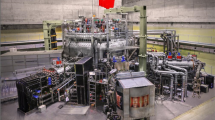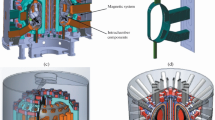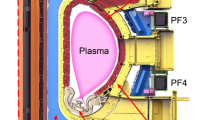Abstract
The LHD-type helical fusion reactor FFHR has been studied to realize steady-state fusion power generation without a need for current drive and free from disruption. The conceptual design studies of FFHR are steadfastly progressing based on the presently ongoing experiments in the Large Helical Device (LHD). In order to enhance the attractive features of the base option of FFHR-d1A, which is similar to LHD, configuration optimization is being considered for FFHR-d1C. Slight modification of the helical coil trajectory gives an improved condition both for the plasma confinement and the MHD stability. In order to overcome the difficulty for construction and maintenance associated with the three-dimensional structure, innovative ideas are being explored for the superconducting magnet, divertor, and blanket. For the superconducting helical coils, the joint-winding method confirms a fast manufacturing process. The helical divertor is reexamined and practical feasibility is discussed. The maintenance method of the helical divertor and the helically-segmented breeder blanket is a serious issue and a plausible solution is proposed.















Similar content being viewed by others
References
A. Sagara et al., Review of stellarator/heliotron design issues towards MFE DEMO. Fusion Eng. Des. 85, 1336 (2010)
A. Sagara et al., Helical reactor design FFHR-d1 and c1 for steady-state DEMO. Fusion Eng. Des. 89, 2114 (2014)
A. Sagara et al., Two conceptual designs of helical fusion reactor FFHR-d1A based on ITER technologies and challenging ideas. Nucl. Fusion 57, 086046 (2017)
A. Sagara et al., Design studies of helical-type fusion reactor FFHR. Fusion Eng. Des. 41, 349 (1998)
L.A. El-Guebaly, Fifty years of magnetic fusion research (1958–2008): brief historical overview and discussion of future trends. Energies 3, 1067 (2010)
A. Komori et al., Development of net-current free heliotron plasmas in the Large Helical Device. Nucl. Fusion 49, 104015 (2009)
Y. Takeiri, Prospect towards steady-state helical fusion reactor based on progress of LHD project entering the deuterium experiment phase. IEEE Trans. Plasma Sci. 99, 1 (2017)
M. Osakabe, Preparation and commissioning for the LHD deuterium experiment. IEEE Trans. Plasma Sci. 99, 1 (2018)
A.H. Boozer, What is a stellarator? Phys. Plasmas 5, 1647 (1998)
C.D. Beidler, Stellarator fusion reactors—an overview. J. Plasma Fusion Res. Ser. 5, 149 (2002)
F. Warmer et al., From W7-X to a HELIAS fusion power plant: motivation and options for an intermediate-step burning-plasma Stellarator. Plasma Phys. Control. Fusion 58, 074006 (2016)
F. Najmabadi et al., The ARIES-CS compact stellarator fusion power plant. Fusion Sci. Technol. 54, 655 (2008)
H. Tamura et al., Design of structural components for the helical reactor FFHR-d1A. Fusion Eng. Des. 89, 2336 (2014)
H. Tamura et al., Design modification of structural components for the helical fusion reactor FFHR-d1 with challenging options. Fusion Eng. Des. 124, 605 (2017)
Y. Chida et al., Validation of welding technology for ITER TF coil structures. Fusion Eng. Des. 86, 2900 (2011)
T. Goto et al., Design window analysis for the helical DEMO reactor FFHR-d1. Plasma Fusion Res. 7, 2405084 (2012)
J. Miyazawa et al., Direct extrapolation of radial profile data to a self-ignited fusion reactor based on the gyro-Bohm model. Fusion Eng. Des. 86, 2879 (2011)
T. Goto et al., Development of a real-time simulation tool towards self-consistent scenario of plasma start-up and sustainment on helical fusion reactor FFHR-d1. Nucl. Fusion 57, 066011 (2017)
S. Okamura, Configuration optimization of planar-axis stellarator with minimum number of Fourier modes of boundary shape. Plasma Phys. Control. Fusion 55, 032002 (2013)
S. Okamura, Configuration optimization of a planar-axis stellarator with a reduced Shafranov shift. Plasma Fusion Res. 8, 2402029 (2013)
N. Yanagi et al., NITA coil—innovation for enlarging the blanket space in the helical fusion reactor. Plasma Fusion Res. 11, 2405034 (2016)
R. Kanno et al., Formation and healing of n = 1 magnetic islands in LHD equilibrium. Nucl. Fusion 45, 588 (2005)
Y. Masaoka, S. Murakami, Study of α-particle confinement in an LHD-type heliotron reactor. Nucl. Fusion 53, 093030 (2013)
R. Seki et al., Monte Carlo study based on a real coordinate system for tangentially injected high-energy particles in the Large Helical Device. Plasma Fusion Res. 5, 027 (2010)
G. Bansal et al., High-temperature superconducting coil option for the LHD-type fusion energy reactor FFHR. Plasma Fusion Res. 3, S1049 (2008)
N. Yanagi et al., Design progress on the high-temperature superconducting coil option for the heliotron-type fusion energy reactor FFHR. Fusion Sci. Technol. 60, 648 (2011)
N. Yanagi et al., Feasibility of HTS magnet option for fusion reactors. Plasma Fusion Res. 9, 1405013 (2014)
N. Yanagi et al., Design and development of high-temperature superconducting magnet system with joint-winding for the helical fusion reactor. Nucl. Fusion 55, 053021 (2015)
S. Imagawa et al., Concept of magnet systems for LHD-type reactor. Nucl. Fusion 49, 075017 (2009)
A. Sagara et al., Optimization activities on design studies of LHD-type reactor FFHR. Fusion Eng. Des. 83, 1690 (2008)
Y. Terazaki et al., Critical current measurement of 30 kA-class HTS conductor samples. IEEE Trans. Appl. Supercond. 24, 4801305 (2014)
Y. Terazaki et al., Measurement and analysis of critical current of 100-kA class simply-stacked HTS conductors. IEEE Trans. Appl. Supercond. 25, 4602905 (2015)
S. Ito et al., Bridge-type mechanical lap joint of a 100 kA-class HTS conductor having stacks of GdBCO tapes. Plasma Fusion Res. 9, 3405086 (2014)
S. Ito et al., Mechanical and electrical characteristics of a bridge-type mechanical lap joint of HTS STARS conductors. IEEE Trans. Appl. Supercond. 26, 4201510 (2016)
K. Uo, et al., Contact resistance of demountable multi-pin joint for superconducting helical coil, in Proceedings of 14th Symposium on Fusion Technology (1986), p. 1727
H. Hashizume et al., Proposal of mechanically jointed superconducting magnet using high critical temperature superconductors. Fusion Eng. Des. 63, 449 (2002)
H. Tamura et al., Multiscale stress analysis and 3D fitting structure of superconducting coils for the helical fusion reactor. IEEE Trans. Appl. Supercond. 26, 4202405 (2016)
T. Nishio et al., Reducing joint resistance by heat treatment during fabrication of a mechanical joint of high-temperature superconducting conductors. IEEE Trans. Appl. Supercond. 26, 4800505 (2016)
N. Yanagi et al., Magnet design with 100-kA HTS STARS conductors for the helical fusion reactor. Cryogenics 80, 243 (2016)
S. Hahn et al., HTS pancake coils without turn-to-turn insulation. IEEE Trans. Appl. Supercond. 21, 1592 (2011)
S. Ito et al., Fundamental investigation on tensile characteristics of a mechanical lap joint of REBCO tapes. IEEE Trans. Appl. Supercond. 25, 4201205 (2015)
S. Ito, et al., Advanced high-temperature superconducting magnet for fusion reactors: segment fabrication and joint technique. Fusion Eng. Des. (2018). https://doi.org/10.1016/j.fusengdes.2018.01.072
K. Uo, The confinement of plasma by the heliotron magnetic field. J. Phys. Soc. Jpn. 16, 1380 (1961)
C. Gourdon et al., The torsatron without toroidal field coils as a solution of the divertor problem. Nucl. Fusion 11, 161 (1971)
H. Nakashima et al., Neutron streaming analysis for helical geometry system, Heliotron-H fusion power reactor. J. Nucl. Sci. Technol. 23, 287 (1986)
T. Tanaka et al., Neutronics investigations for helical demo reactor FFHR-d1. Plasma Fusion Res. 7, 2405132 (2012)
H. Tamura et al., Novel divertor design to mitigate neutron irradiation in the helical reactor FFHR-d1. Fusion Eng. Des. 98–99, 1629 (2015)
H. Tamura et al., Radial-build design and support system for the helical DEMO reactor FFHR-d1. Fusion Eng. Des. 88, 2033 (2013)
S. Masuzaki et al., The divertor plasma characteristics in the Large Helical Device. Nucl. Fusion 42, 750 (2002)
S. Masuzaki et al., Edge plasma transport in the helical divertor configuration in LHD. Contrib. Plasma Phys. 50, 629 (2010)
M. Kobayashi et al., Control of 3D edge radiation structure with resonant magnetic perturbation fields applied to the stochastic layer and stabilization of radiative divertor plasma in LHD. Nucl. Fusion 53, 093032 (2013)
N. Yanagi et al., Heat flux reduction by helical divertor coils in the heliotron fusion energy reactor. Nucl. Fusion 51, 103017 (2011)
Y. Nakamura et al., Impact of real-time magnetic axis sweeping on steady state divertor operation in LHD. Nucl. Fusion 46, 714 (2006)
N. Yanagi, et al., Divertor heat flux reduction by resonant magnetic perturbations in the LHD-type helical demo reactor, in 24th IAEA Fusion Energy Conference, San Diego (2012) FTP/P7-37
J. Miyazawa et al., Conceptual design of a liquid metal limiter/divertor system for the FFHR-d1. Fusion Eng. Des. 125, 227 (2017)
F.L. Tabarés, Present status of liquid metal research for a fusion reactor. Plasma Phys. Control. Fusion 58, 014014 (2016)
T. Morisaki et al., Review of divertor studies in LHD. Plasma Sci. Technol 8, 14 (2006)
N. Ohyabu et al., The Large Helical Device (LHD) helical divertor. Nucl. Fusion 34, 387 (1994)
G. Kawamura et al., First EMC3-EIRENE simulations with divertor legs of LHD in realistic device geometry. Contrib. Plasma Phys. 54, 437 (2014)
A. Sagara et al., Blanket and divertor design for force free helical reactor (FFHR). Fusion Eng. Des. 29, 51 (1995)
J. Yagi et al., Hydrogen solubility in FLiNaK mixed with titanium powder. Fusion Eng. Des. 98–99, 1907 (2015)
A. Sagara et al., First operation of the Flinak/LiPb twin loop OROSH2I-2 with a 3T SC magnet for R&D of liquid blanket for fusion reactor. Fusion Sci. Technol. 68, 303 (2015)
A. Sagara et al., Conceptual design activities and key issues on LHD-type reactor FFHR. Fusion Eng. Des. 81, 2703 (2006)
T. Goto et al., Proposal for the method of maintaining breeder blankets in the LHD-type helical fusion reactor FFHR. Plasma Fusion Res. 11, 2405047 (2016)
J. Miyazawa et al., Cartridge-type helical blankets aiming at easy construction and maintenance for the FFHR-d1. Plasma Fusion Res. 12, 1405017 (2017)
W.T. Shmayda et al., Dependence of tritium release from stainless steel on temperature and water vapor. Fusion Sci. Technol. 68, 1 (2015)
M. Yoda, et al., Underwater laser beam welding for nuclear reactors, in Proceedings on 2012 20th International Conference on Nuclear Engineering and the ASME 2012 Power Conference, Anaheim, California, USA, July 30–August 3, 2012 (2012), p. 191
K. Sako et al., Design study of swimming pool type tokamak reactor (SPTR). J. Nucl. Sci. Technol. 19, 491 (1982)
Acknowledgements
The authors thank the members of the Fusion Engineering Research Project at NIFS, especially, T. Mito, S. Hamaguchi, S. Imagawa, K. Takahata, A. Iwamoto, T. Obana, H. Chikaraishi, N. Ashikawa, M. Tokitani, G. Kawamura, Y. Hamaji, R. Sakamoto, and S. Masuzaki for fruitful discussions. Special thanks are given to T. Muroga and H. Yamada. One of the authors (N. Y.) is grateful for the continuous discussion and encouragement given by A. Komori regarding the feasibility of the helical divertor. The optimized configuration provided by S. Okamura is highly appreciated. The NITA coil configuration was proposed by the late T. Watanabe, who made tremendous contributions to the FFHR design activities. The design of the helical divertor and the helically-segmented blanket made by S. Kinoshita at Hitachi Ltd. are greatly acknowledged. This work was supported in part by the Japan Society for the Promotion of Science (JSPS) Grant-in-Aid for Scientific Research (S) under Grant 26220913.
Author information
Authors and Affiliations
Corresponding author
Rights and permissions
About this article
Cite this article
Yanagi, N., Goto, T., Miyazawa, J. et al. Progress in the Conceptual Design of the Helical Fusion Reactor FFHR-d1. J Fusion Energ 38, 147–161 (2019). https://doi.org/10.1007/s10894-018-0193-y
Published:
Issue Date:
DOI: https://doi.org/10.1007/s10894-018-0193-y




